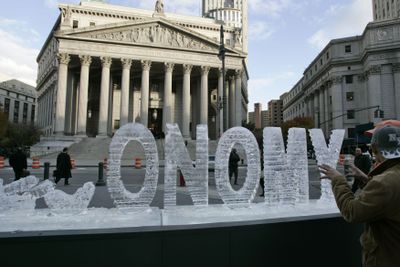Homeowner help in the works
Feds would back loans

WASHINGTON – Negotiators for the Treasury and Federal Deposit Insurance Corp. are nearing agreement on a plan to have the government guarantee the mortgages of millions of distressed homeowners in what would be a significant departure for the federal rescue program, which has so far directed relief exclusively to banks and other financial institutions.
The plan, which sources said could cover as many as 3 million homeowners in danger of foreclosure and cost between $40 billion and $50 billion, would go well beyond previous government and private-sector initiatives. Critics say these have attracted too few lenders or offered too little aid to homeowners to stem the foreclosure crisis.
But with economic anxieties continuing to mount and political pressure growing for expanded help to homeowners, federal officials could announce a new program to cover as much as $600 billion in mortgage loans in the coming days, sources said. They spoke on condition of anonymity because the negotiations were ongoing.
Treasury officials confirmed Wednesday that discussions were under way for homeowner aid but said that any figures remained fluid and that other options were under consideration, as well.
Several sources said the mortgage program still faces resistance from the White House. A spokesman for President Bush said Wednesday night that the administration was analyzing various proposals.
“We have been reviewing a number of housing proposals for some time and no decisions have been made on any of them. Any inference that we’re ‘nearing’ a decision on any one of them is simply wrong,” said White House spokesman Tony Fratto.
The possible details of the homeowner bailout emerged Wednesday, another day of extraordinary measures by U.S. and foreign governments to arrest the financial crisis.
The Federal Reserve cut interest rates for the second time in two weeks and, in a move that exposes it to the risk of lending to developing nations for the first time, said it would pump up to $120 billion into the central banks of Mexico, Brazil, Singapore and South Korea.
The International Monetary Fund said it would offer as much as $100 billion in emergency loans to developing countries staggered by investor flight and runs on their currencies and stock markets. Earlier this week, the European Central Bank said it would join the IMF in a $21 billion bailout of Hungary, and China’s central bank cut the interest rate it controls.
At the U.S. Treasury, a growing number of financial institutions and other companies have been lobbying to get a slice of the $700 billion federal bailout.
Some foreign banks are asking to participate in the Treasury’s bank investment program because “this is a global crisis,” according to a letter from the Financial Services Roundtable, a trade association for large financial firms.
The nation’s two major bond insurers sent letters making suggestions on shaping the rescue plan, with one asking that the government cover a portion of their losses to prevent a “systemic implosion” of the economy.
Meanwhile, General Motors wants some of the rescue money to help it merge with Chrysler, and insurance companies have asked that they be given the same rights that banks have received under the rescue.
“Everyone has their hand out now,” said a lobbyist who represents one of the industries recently in touch with the Treasury. The lobbyist declined to comment further for fear of hurting the industry’s case. “It’s a lot of money, and people are hurting.”
While the financial crisis is rooted in the ailing mortgage market and the wave of foreclosures sweeping the nation, none of the $700 billion rescue package approved by Congress has yet been directly targeted at struggling homeowners.
Under the program being discussed, banks or other lenders would agree to reduce the monthly payments of borrowers to a level they could afford. The payments could be reduced by lowering the interest rate, cutting the amount owed or extending the repayment period. The goal would be to help homeowners avert foreclosure.
In exchange, lenders who agree to do this would get a government guarantee that they would be compensated for a portion of any losses should borrowers default on the reconfigured loans.
One of the toughest issues facing negotiators is how to define which struggling homeowners should get a bailout. If the government guarantees relatively risky loans, it is more likely to face a steeper tab. So if the gap between a household’s income and what it owes on a mortgage is large, for example, the government may shy away from guaranteeing the loan.
Aware that how they define homeowner eligibility could cause a political furor, negotiators have struggled to come up with parameters that would be considered fair, a banking industry source said.